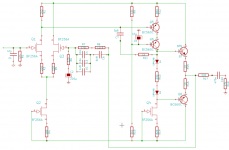Dear all,
I'd like to try attached MM phono stage with active EQ. This simple design would consist of a LTP fet input stage, cascoded VAS and a push pull output stage.
I carried out the following thoughts:
* When I listen to the phono stage of my NAD, I don't think NFB is evil. Why not design an active riaa EQ?
* For DC decoupling, C2 must be an electrolytic. Because its tolerance it hardly can serve as an rumble filter.
* So low frequency roll off is done by the loop's gain. It is deliberately set to "just enough". Tweaking of the bass resonse can be done be changing R4's value.
* Cascoding the voltage amplifier can't be a bad thing Can it?!? Why?
* The output stage should isolate against changing output impedances, caused e. g. by a (dis-) connected PC sound card input. A push pull stage does this better than a single ended one.
Can you please cirtisize this design.
Cheers,
Hassan
I'd like to try attached MM phono stage with active EQ. This simple design would consist of a LTP fet input stage, cascoded VAS and a push pull output stage.
I carried out the following thoughts:
* When I listen to the phono stage of my NAD, I don't think NFB is evil. Why not design an active riaa EQ?
* For DC decoupling, C2 must be an electrolytic. Because its tolerance it hardly can serve as an rumble filter.
* So low frequency roll off is done by the loop's gain. It is deliberately set to "just enough". Tweaking of the bass resonse can be done be changing R4's value.
* Cascoding the voltage amplifier can't be a bad thing Can it?!? Why?
* The output stage should isolate against changing output impedances, caused e. g. by a (dis-) connected PC sound card input. A push pull stage does this better than a single ended one.
Can you please cirtisize this design.
Cheers,
Hassan
Attachments
With NFB you either need none or enough. You can use none when the amp is inherently linear, or you want an effects box. Everywhere else you need enough, so that the higher order terms introduced by the low order intrinsic nonlinearity mixing with itself and the input signal via the NFB is sufficiently suppressed so you don't end up worse off. 'Enough' typically means at least 15-20dB. This won't happen at LF in your design.
If your circuit is sufficiently linear that it can run open loop with low distortion, and the open loop gain is sufficiently precisely defined by resistors or guaranteed BJT characteristics, then you can get away with your 'minimal gain' idea. Otherwise not. A simulation won't tell you the answer to this, unless you vary things and see how much the gain changes.
If your circuit is sufficiently linear that it can run open loop with low distortion, and the open loop gain is sufficiently precisely defined by resistors or guaranteed BJT characteristics, then you can get away with your 'minimal gain' idea. Otherwise not. A simulation won't tell you the answer to this, unless you vary things and see how much the gain changes.
I intended the casocde to do this. Simulation shows a significant reduction of distortion compared to the even more simple one transistor VAS.If your circuit is sufficiently linear that it can run open loop with low distortion
Simulation also tells me that it won't play out of the box, but some tweaking is necessary: Already changing transistor types and hfe classes has a major influence on the frequency response.
OTOH I could squeeze some more open loop gain out of it, to strenghen it against the "real world". Parameter variations then would be of less influence, a HP at the input could serve as the rumble filter.
I will build and measure this circuit, record it's output course listen to it.
Thank you for your input,
hassan
- Status
- Not open for further replies.
